Cambodia
Temples of Angkor
Ta Prohm
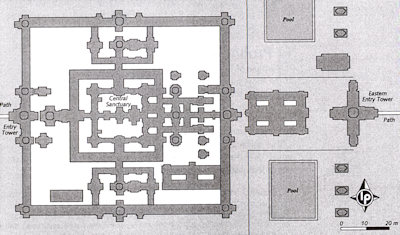
Ta Prohm was left untouched by archaeologists, exept for the clearing of a path for visitors and structural strengthening to stave
off further deterioration.
Because of its natural state, it is possible to experience at this temple some of the wonder of the early explorers, when thy came
upon these monuments in the middle of the 19th century. Shrouded in jungle, the temple of Ta Prohm is ethereal in aspect and conjures
up a romantic aura.
Trunks of trees twist amongst stone pillars. Fig, Banyan and Kapok trees spread their gigantic roots over, under and in between the
stones, probing walls and terraces apart, as their branches and leaves intertwine to from a roof above the structures.
Built around 1186, Ta Prohm, was a Buddhist temple dedicated to the mother of Jayavarman VII.
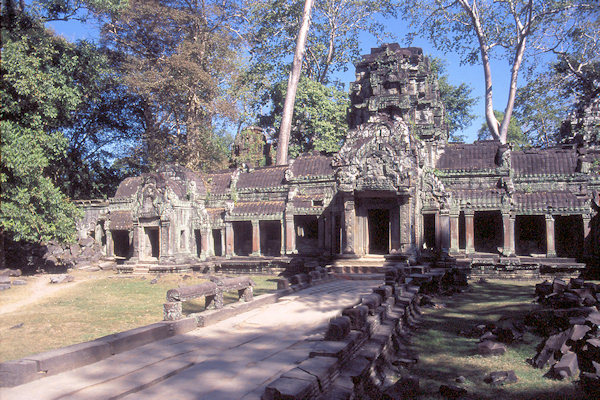 |
|||||
It is one of the few temples in the Angkor region where an inscription provides information about the temple's dependents and
inhabitants. The numbers quoted really are staggering, although possibly include an element of exaggeration to glorify the king;
close to 80.000 people were require to maintain or attend at the temple, among them more than 2.700 officials and 615 dancers.
The monastic complex of Ta Prohm is a series of long, low buildings standing on one level connecting with passages and concentric
galleries framing the main structure.
A rectangular, laterite wall (700 by 1.000 metres) encloses the entire complex.
While this temple was originally built according to the symmetrical, repetitive plan that is hallmark to Khmer architecture, Ta Prohm
seems haphazerd and some areas of the temple are impassable; others are accesible only by narrow covered passages and, of course, much
of the temple's fascination for the visitors lies in this disarray.
Neak Pean
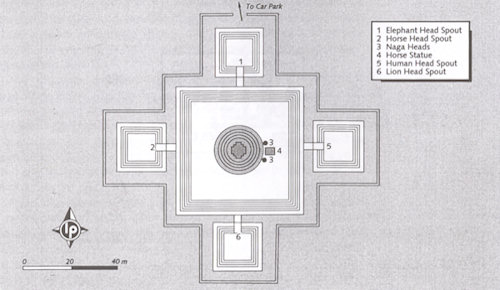
The temple of Neak Pean is set in a large, square, man-made pond, bordered by steps and surrounded by four smaller ponds.
The central pond is a replica of Lake Anavatapta in the Himalayas, situated at the top of the universe, which gives birth to the
four great rivers of the earth.
These rivers are represented at Neak Pean by sculpted gargoyles corresponding to the four cardinal points. Lake Anavatapta was fed by
hot springs and venerated in India for the curative powers of its waters.
Neak Pean was probably consecrated
to the Buddha coming to the glory of enlightment. The shrine in the middle of the central pond was engulfed by a tree until 1935, when
it was destroyed by a storm.
A small circular island, with stepped base of seven laterite tirs, is in the centre of the large square pond, and forms the base for
a shrine dedicated to Avalokiteshvara.
Small elephants sculpted in the round originally stood on the four corners of the pond. The bodies of two serpents encircle the base of
the island and their tails entwine on the west side.
The tree false doors of the central shrine are decorated with large images of Avalokiteshvara.
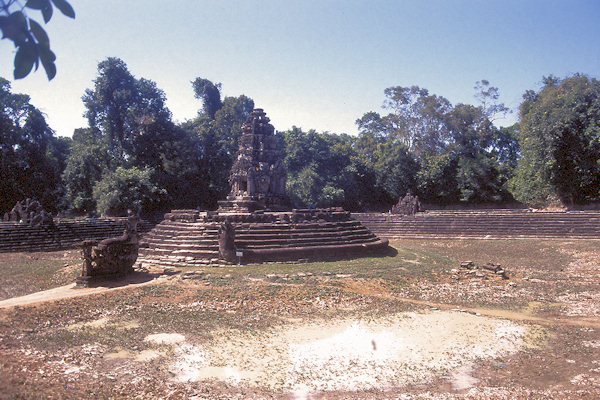 |
|||||
The principal feature in the pond is the three-dimensional sculpted horse swimming towards the east with figures to its side. The
horse Balaha, is a manifestation of the bodhisattva Avolokiteshvara, who has transformed himself into a horse to rescue Simhala,
a merchant, and his companions of misfortune. They were shipwrecked on an island off Sri Lanka and snatched by female ogresses. The victims
are holding on the horse's tail in the hope of being carried ashore safely.
There are four small chambers backed onto the main pond and opening onto four small ponds with steps leading to the water. The four
buildings served a ceremonial function, where pilgrims could absolve themselves of their sins.
They anointed themselves with lustral water, which flowed from the spout connected to the central pond. Each water spout is different;
(north) "elephant head"; (east) "human head"; (south) "lion"; (west) "horse".
Beng Mealea
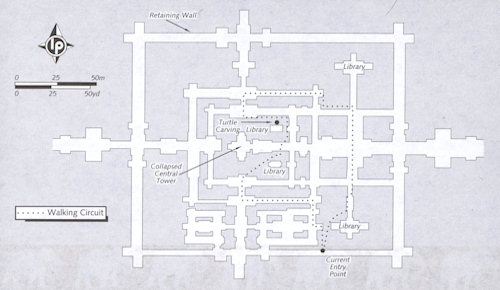
Beng Mealea is a spectacular sight to behold, one of teh most mysterious temples of Angkor, as nature has well and truly run riot
here.
This 12th-century temple, built under Surayvarman II (reigned 1112-52), is very similar in design to Angkor Wat, although only
on a single level and not multilayered.
Beng Mealea is enclosed by a massive moat measuring 1.200m by 900m, most of which has dried up today.
The temple has been utterly subsumed by jungle; and standing just a few metres away from the trees it is hard to tell what lies beneath.
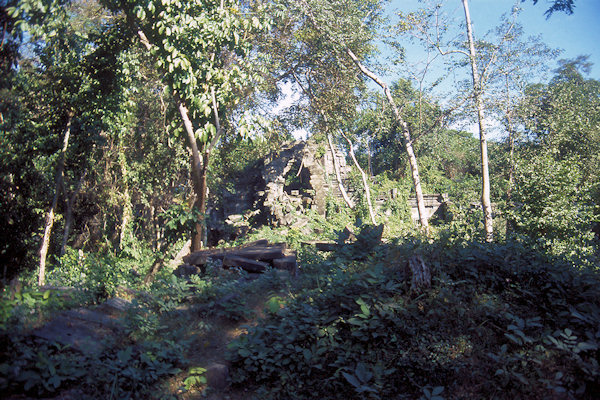 |
|||||
Entering from the south, visitors wend their way over piles of masonry, through long dark chambers and between hanging vines to
arrive at the central tower, which has completely collapsed.
Hidden away among the rubble and foliage are several impressive carvings, as well as a well-preserved library in the notheastern quadrant.
It is a special place and it is worth taking the time to explore thoroughly.
Beng Mealea lies at the centre of an ancient Angkorian road connecting Angkor Thom and Preah Khan in the Preah Vihear Province.
There is no charge to visit Beng Mealea. It is best to undertake a long day trip combining Beng Mealea, Kbal Spean and Banteay Srei.
Beng Mealea is about 60 km east of Siem Reap and it will take about two hours to reach it.
Banteay Srei

Banteay Srei is a Hindu temple dedicated to Shiva.
Considered by many to be the jewel in the town of Angkorian art, the temple is cut from stone of a pinkish hue and includes some of
the finest stone carving seen anywhere on the planet.
It is not particularly extensive temple site, but it is wonderfully well preserved and many of its carvings are three-dimensional.
Banteay Srei means "Citadel of the Women" and it is said that it must have been built by a woman, as the elaborate carvings are
too fine for the touch of a man.
Construction on Banteay Srei began in 967 and it is one of the few temples around Angkor not to be commissioned by a King, but by a
Brahim who may have been a tutor to Jayavarman V (reigned 968-1001).
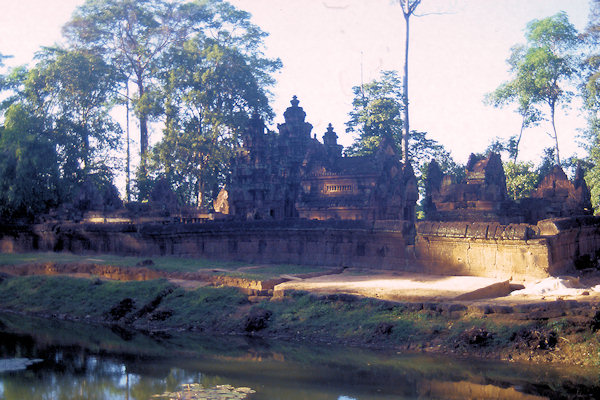 |
|||||
Of interest are the lavishly decorated libraries and the three central towers, which are decorated with male and female divinities
and beautiful filigree relief work.
Classic carvings at Banteay Srei include delicate woman with lotus flowers in hand and traditional skirts clearly visible, as
well as breath-taking re-creations of scenes from the epic Ramayana adomimg the library frontons (carved inlays above a lintel).
However the sum of the parts is no greater than the whole - almost every inch of these interior buildings is covered in decoration.
Standing watch over such perfect creations are the mythical guardians, all of which are copies of originals stored in the National
Museum.
Banteay Srei is about 32km from Siem Reap and it should take 45 minutes to get there.
Kbal Spean
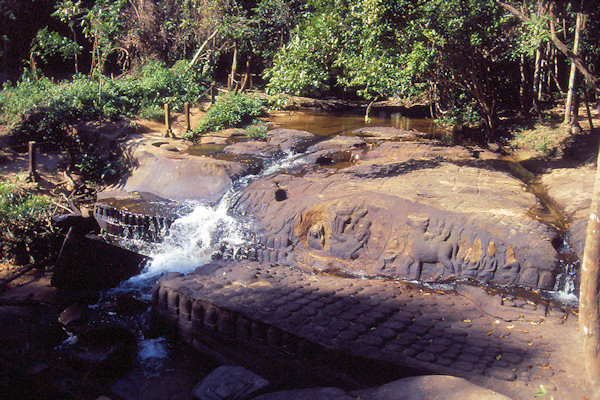 |
|||||
Kbal Spean is a spectacularly carved riverbed, set deep in the jungle to the northeast of Angkor.
More commonly referred to in English as "The River of a Thousand Lingas", the name actually means "Bridgehead", a reference
to the naturl rock bridge at the site.
It is about a half-hour walk to where the carvings ebgin along a plaesant path that winds its way up into the jungle. It is best to
start with the river carvings and work your way back down to the waterfall.
There is an impressive carving of Vishnu on the upper section of the river, followed by a series of carvings at the bridgehead
itself (including Shiva's mount Nandi).
Following the river down there are several more impressive carvings of Vishnu and Shiva with his consort Uma, and farther
downstream hundreds of Lingas appear on the riverbed.
At the top of the waterfall, there are many animal images, including a cow and a frog.
Kbal Spean is about 50 km northeast of Siem Reap and takes about 1 1/2 hour to reach.
Rolous Group
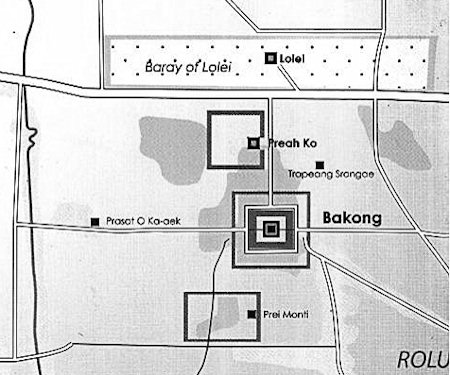
The monuments of Rolous, which served as Indravarman I (reigned 877-89) capital, Haliharalaya, a name derived from the
god
Hari-Hara, a synthesis of "Shiva" and "Vishnu" are among the earliest large, permanent temples built by the Kmer's
and mark the beginning of the age of Kmer classical art.
Before the construction of Rolous, generally only lighter (and less-durable) construction materials such as brick were employed.
The temples can be found 13km east of Siem Reap.
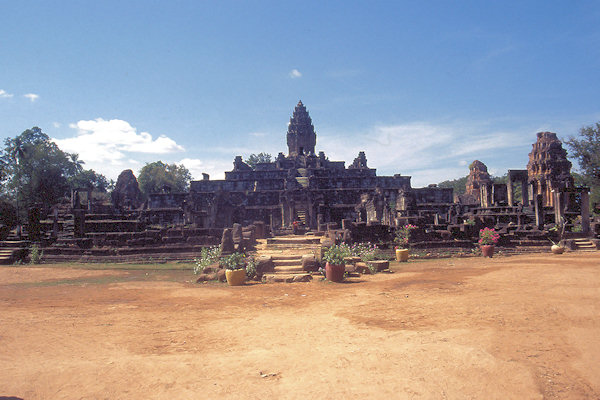 |
|||||
Bakong is the largest and most interesting of the Rolous group temples and has an active Buddhist monastry just to the north
of the east entrance. It was built and dedicated to Shiva by Indravarman I.
Built as a representation of Mt Meru, it served as the city's central temple. The east-facing complex consists of a five-tier
central pyramid of sandstone, 60 m square at the base, flanked by eight towers (or what's left of them) of brick and sandstone and by
other minor sanctuaries.
Several of the eight towers down below are still partly covered by their original plasterwork.
The complex is enclosed by three concentric walls and a broad moat.
There are well-preserved statues of stone elephants on each corner of the first three levels of the central temple. There are 12 stupas
- four to a side - on the third tier.
The sanctuary on the fifth level was a later addition.
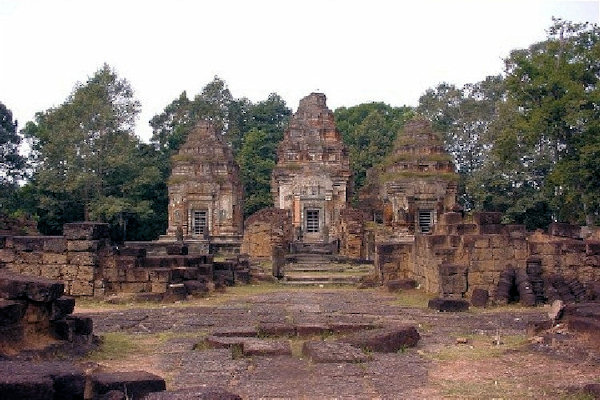 |
|||||
Preah Ko was erected by Indravanrman I in the late 9th century.
The temples of Preah Ko ("Sacred Ox") feature three Nandi in front of the firts row of temple, all in poor condition.
Preah Ko was dedicated by Indravarman to his deified ancestors. The front towers relate to the male ancestors or gods, the rear towers
to the female ancestors or goddesses.
The four brick towers of Lolei were built on an islet in the middle of a large reservoir - now rice fields - by Yasovarman I
(reigned 889 - 910)
According to an inscription found at the temple, the water in this pond was for use at the capital of Hariharalaya and for irrigating
the plains in the area.
The four towers appear randomly placed on a raised brick platform.